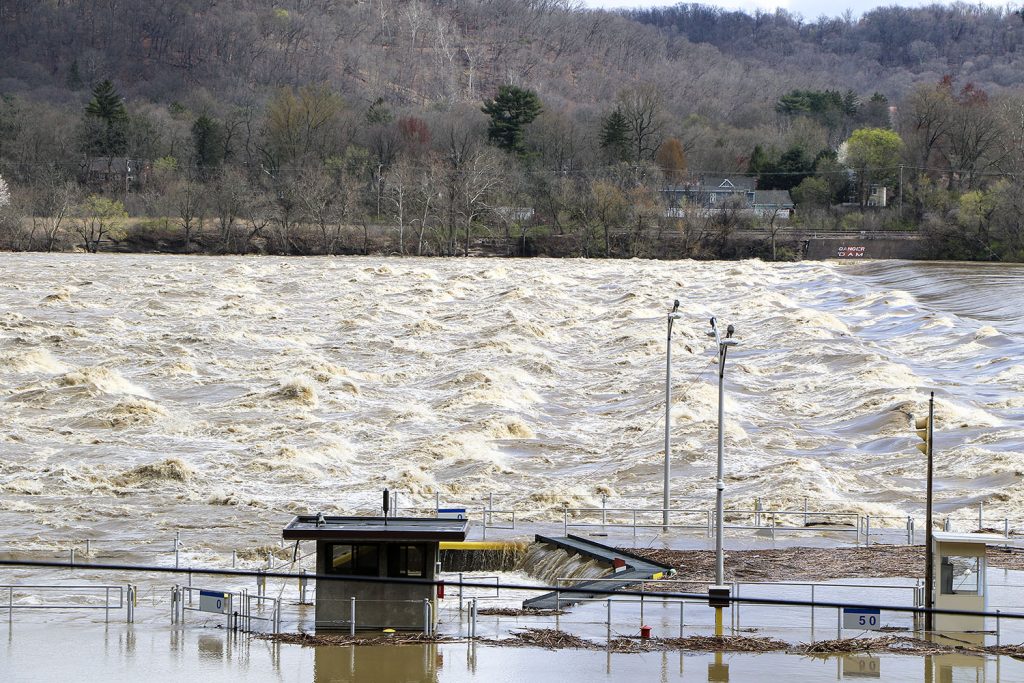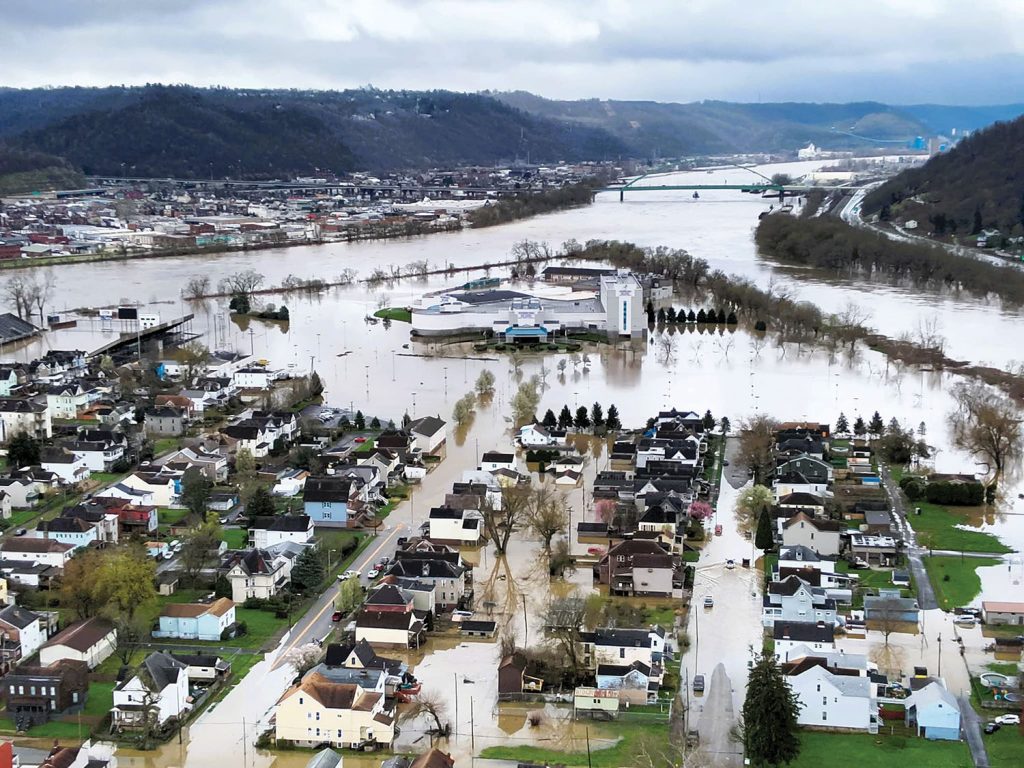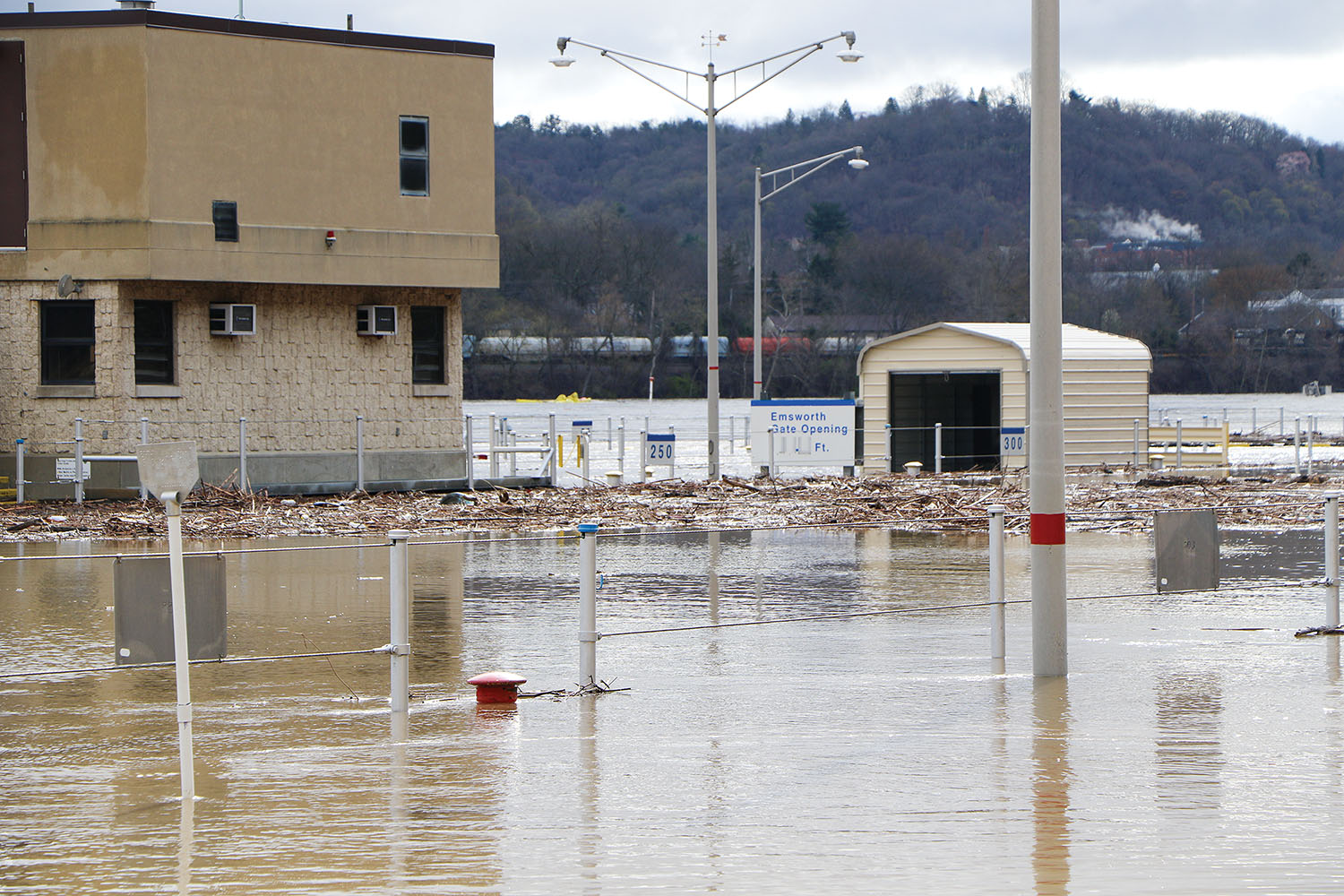Within 48 hours April 3–5, the most extensive flood in the Pittsburgh area since 2005 came and went.
Alan Nogy, the Pittsburgh Engineer District’s operations project manager for locks and dams, said that 11 of the district’s 23 facilities went out of service between 8:30 a.m. April 3 and 7:30 a.m. April 4, with the river overtopping the lock walls at Charleroi, Elizabeth and Braddock locks on the Monongahela, Allegheny locks 8, 5 and 4, and Dashields on the Ohio.
Nogy, who has worked on the river for 27 years, said it was among the top five high-water events he has seen.
Thankfully, however, he said there appeared to be no major damage.
“That’s a testament to our guys and the way they prepare and the way they clean up,” he said.
Minor damage included snapped cables, inoperable small electrical components including solenoid valves, and metal grating on some lock walls that needs to be replaced.
By the morning of April 5, the water was dropping, and locks were beginning to reopen, with Montgomery Lock and Dam the first back online about 8 a.m. that day and five more following later in the day. Three more locks reopened on April 6, one on April 7, and the final one, Lock 5 on the Allegheny, on April 9.

Nogy said the new lock at Charleroi was one of the locks overtopped by the water.
“When the water gets over the top of the walls, it’s a whole different game,” he said.
Crews continued to inspect components and assess for any damage.
The sudden rise and fall of the river was due to intense and widespread rain. While photos circulated quickly on social media, showing the “point” at the head of the Ohio River in downtown Pittsburgh under water, Nogy pointed out that it would have had 6 to 8 feet of water on top of it if the district’s flood control facilities hadn’t been able to hold back water.
“They make a tremendous difference for everybody along the river,” he said.”
He also noted the importance of communication, including daily conference calls hosted by the navigation committee for the Waterways Association of Pittsburgh.
Shane Checkan, navigation committee chairman, called the rapid rise brutal, noting that while high water lower on the Ohio isn’t uncommon, the much narrower Allegheny and Monongahela rivers are prone to rapid rises and falls. He noted that gauges at the point in Pittsburgh showed the water had risen from its normal pool at 16.3 feet to 28.3 feet over two days.
“We got through this relatively unscathed,” he said.
Checkan is general manager of Industry Terminal & Salvage, and he said his company’s experience was probably typical of most, with April 8 being the first day barges had been delivered at a terminal since April 3 as companies moved lines, secured fleets, looked out for drift and waited for locks to reopen. Crews also spent time cleaning water out of buildings, he said.
On the conference calls, he said the group stressed, “The fall is just as dangerous if not more dangerous because a lot of times it’s faster than the rise.”
He also credited training programs the various companies have in place to help crews know how to react during rapid rises and falls and “the quality of mariners we have in Pittsburgh, the men and women who go out there and do the work, the boots on the ground.”
“We can communicate forever, but they still have to go out there and do that work,” he said.
The Ohio remained 7 to 8 feet above normal pool, Checkan said, and the weather forecast called for another 1-1/2 inches of rain, which meant those in the industry continued to pay close attention.
“You’ve got to stress to everybody that you don’t get complacent,” he said.
Effects Downriver
Several cities downriver on the Ohio faced their own problems due to flooding.
The Ohio River crested in Wheeling, W.Va., the evening of April 4 at 41.49 feet, according to the National Weather Service, then dropped back below the flood stage of 36 feet on April 5.

Dan Weaver, planning officer for emergency management for Ohio County, West Virginia, said nearly all of the 1,161 structures on Wheeling Island in Wheeling, W.Va., had water in their basements, if they had them. Wheeling Island is the second-most densely populated island in the country, trailing only Manhattan, he pointed out. At least one home had water damage on the first floor, he said. Mud slides had also been a problem, he said, with one home taking on mud from a slide. Some areas experienced electricity outages.
Another 100 or so homes and businesses in South Wheeling also had water in basements, he estimated. The local health department gave out free tetanus shots to those cleaning up from the flood.
Navigation interests along the river fared better, according to the Coast Guard.
“We have had no significant issues or accidents directly related to the rise in the river,” said Lt. Steve Leighty, chief of the inspections division and public affairs officer for Coast Guard Sector Ohio Valley. “This rise was quick, which historically is the most dangerous. However, our waterway action plan has been in full swing, and aside from the great amount of drift and the occasional dock breaking away, the only restriction we have had in effect is the daylight-only restriction at McAlpine Lock and Dam (Louisville, Ky.) which will be lifted when the McAlpine upper pool drops back below 18 feet on the gauge reading.”
McAlpine Salvage
Brad Stout, the Louisville Engineer District’s operations manager for locks and dams, said the flood helped in one way, flushing through a partially sunken coal barge that had been stuck in a gate bay since March 8, when 10 coal barges broke loose from their tow after exiting the lock.
“Due to high water on 4 April 2024, the barge that was pinned in gate bay 2 of the lower dam site flushed through the dam,” he said in a statement.
Vessels that were downstream of McAlpine Locks and Dam were able to secure the barge and transport it to the bank, he said.
“Currently, there is only one barge remaining from the accident, and it is below the lower dam site,” Stout said. “This barge will be salvaged once the lower gauge drops, and the barge becomes visible again.”
Caption for top photo: The river wall at Dashields Locks was completely underwater on April 4. (Photo by Daniel Jones/Pittsburgh Engineer District)




